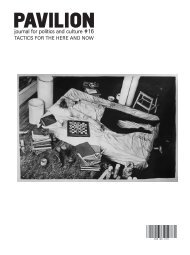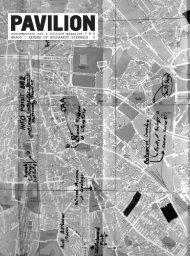PAVILION
PAVILION
PAVILION
- No tags were found...
You also want an ePaper? Increase the reach of your titles
YUMPU automatically turns print PDFs into web optimized ePapers that Google loves.
Pablo Bronstein & Eleanor Vonne Brown<br />
10 Gypsy Dances<br />
Pablo Bronstein initially choreographs ten<br />
dances on a sheet of paper. These dances are<br />
for a variety of performers, ranging from solo<br />
pieces, pas de deux, to a piece for unlimited<br />
numbers of male and female dancers. The<br />
choreographies are thus both temporal<br />
instructions, and spatial diagrams; looking at<br />
the page acts as if one were looking down at a<br />
dance floor. These pages are then passed to<br />
Elle Brown who turns them into both readable<br />
instructions for the layman - words replacing<br />
lines - and concrete poetry simultaneously.<br />
The hypothesis being that concrete poetry is a<br />
choreography with words, and similarly, that<br />
dancing is an acting-out of a concrete poem.<br />
Bronstein creates dances based on almost no<br />
knowledge of Gypsy culture. These abstract<br />
‘Gypsy’ style dances are a comment on the<br />
romantic exoticism of the 19th and 20th century<br />
stage, as well as playing on modern nationalistic<br />
interests in folk culture. Brown takes<br />
these didactic and reductive dances and transforms<br />
them into a semi-parody of high<br />
Modernism.<br />
From something vaguely danceable the<br />
instructions become high-end cultural product<br />
for elite audiences. The work appears at first a<br />
condensed history of arrogance and misreading,<br />
with both artists in succession creating<br />
and exacerbating a remoteness to popular culture.<br />
The underlying point, however, is that<br />
these dances as transcribable events never<br />
existed in the first place, nor is the poem a<br />
form of accurate communication of movement<br />
in time and space, and thus the work is ultimately<br />
an abstract exercise in translation and<br />
of reading texts in parallel.<br />
Zece dansuri tigănesti<br />
, ,<br />
[408]<br />
Pablo Bronstein coregrafiază inițial<br />
zece dansuri pe o foaie de hârtie. Aceste<br />
dansuri sunt concepute pentru o varietate de<br />
interpreți, de la piese solo, pas de deux, la o<br />
piesă pentru un număr nelimitat de dansatori<br />
de ambele genuri. Astfel, coreografiile sunt<br />
atât instrucțiuni temporale cât și diagrame<br />
spațiale; a te uita la pagină este ca și cum ai<br />
observa un ring de dans. Aceste pagini sunt<br />
apoi trimise lui Elle Brown care le transformă<br />
în instrucțiuni lizibile pentru omul obișnuit -<br />
cuvintele înlocuiesc liniile - dar și în poezie<br />
concretă simultan. Ipoteza este că poezia concretă<br />
este o coreografie în cuvinte și în mod<br />
similar, dansul este o interpretare a unui poem<br />
concret. Bronstein creează dansuri bazate pe<br />
aproape nici o cunoștință despre cultura<br />
rromă. Aceste dansuri abstracte în stil "țigănesc"<br />
sunt un comentariu la exotismul romantic<br />
al scenei de secol xIx și xx, precum și<br />
interesul naționalist modern pentru cultura folclorică.<br />
Brown preia aceste dansuri didactice<br />
și reducționiste și le transformă într-o semiparodie<br />
a modernismului înalt.<br />
Pentru un lucru vag dansabil,<br />
instrucțiile devin un produs cultural de înaltă<br />
clasă pentru publicul de elită. Lucrarea apare<br />
inițial ca o istorie condensată despre aroganță<br />
și interpretare greșită, ambii artiști creând succesiv<br />
și exacerbând o depărtare față de folclor.<br />
Ideea de bază, însă, este că aceste dansuri<br />
sunt evenimente ce nu au existat niciodată dar<br />
pot fi transcrise, iar poemul nu este o formă de<br />
comunicare exactă a mișcării în timp și spațiu<br />
și astfel lucrarea este de fapt un exercițiu<br />
abstract de traducere și citire de texte în paralel.<br />
Pablo Bronstein and Eleanor Vonne Brown: 10 Gypsy Dances, 2010. Fig 1<br />
[409]








